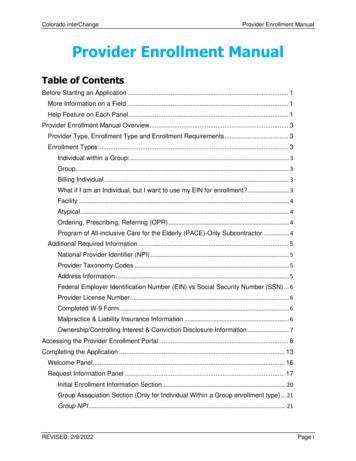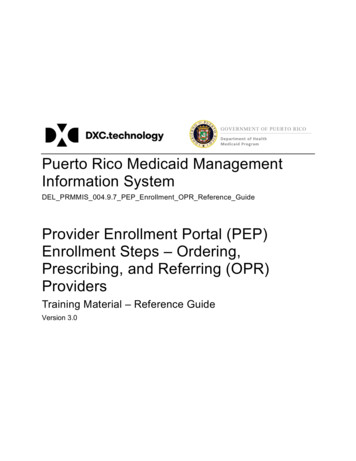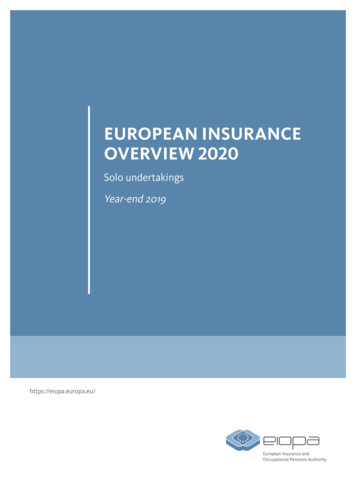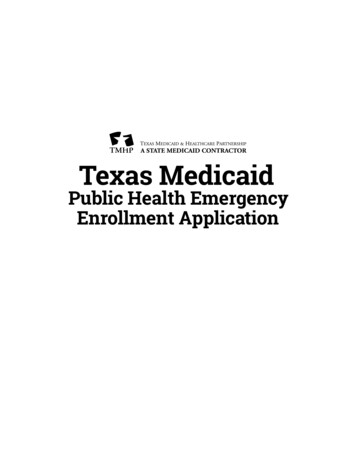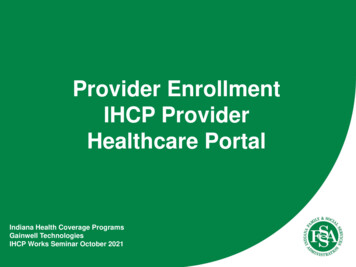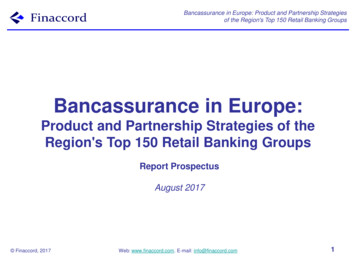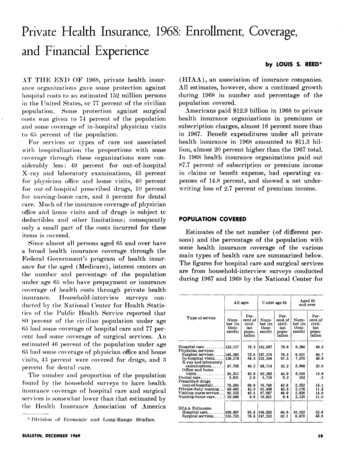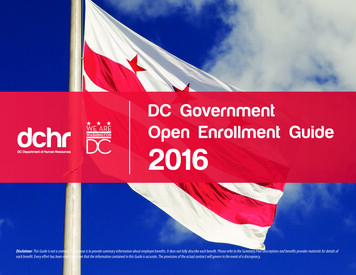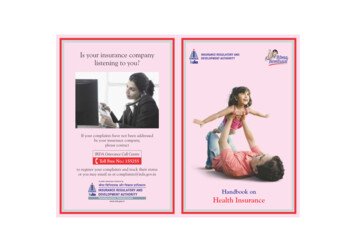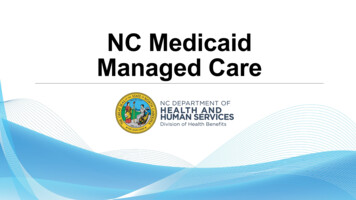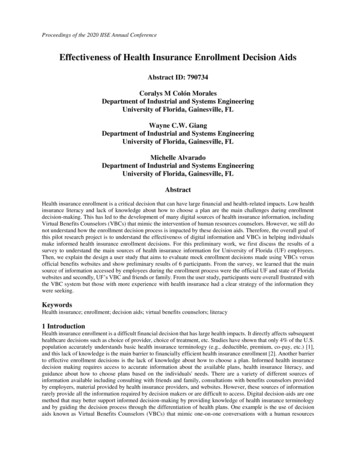
Transcription
Proceedings of the 2020 IISE Annual ConferenceEffectiveness of Health Insurance Enrollment Decision AidsAbstract ID: 790734Coralys M Colón MoralesDepartment of Industrial and Systems EngineeringUniversity of Florida, Gainesville, FLWayne C.W. GiangDepartment of Industrial and Systems EngineeringUniversity of Florida, Gainesville, FLMichelle AlvaradoDepartment of Industrial and Systems EngineeringUniversity of Florida, Gainesville, FLAbstractHealth insurance enrollment is a critical decision that can have large financial and health-related impacts. Low healthinsurance literacy and lack of knowledge about how to choose a plan are the main challenges during enrollmentdecision-making. This has led to the development of many digital sources of health insurance information, includingVirtual Benefits Counselors (VBCs) that mimic the intervention of human resources counselors. However, we still donot understand how the enrollment decision process is impacted by these decision aids. Therefore, the overall goal ofthis pilot research project is to understand the effectiveness of digital information and VBCs in helping individualsmake informed health insurance enrollment decisions. For this preliminary work, we first discuss the results of asurvey to understand the main sources of health insurance information for University of Florida (UF) employees.Then, we explain the design a user study that aims to evaluate mock enrollment decisions made using VBCs versusofficial benefits websites and show preliminary results of 6 participants. From the survey, we learned that the mainsource of information accessed by employees during the enrollment process were the official UF and state of Floridawebsites and secondly, UF’s VBC and friends or family. From the user study, participants were overall frustrated withthe VBC system but those with more experience with health insurance had a clear strategy of the information theywere seeking.KeywordsHealth insurance; enrollment; decision aids; virtual benefits counselors; literacy1 IntroductionHealth insurance enrollment is a difficult financial decision that has large health impacts. It directly affects subsequenthealthcare decisions such as choice of provider, choice of treatment, etc. Studies have shown that only 4% of the U.S.population accurately understands basic health insurance terminology (e.g., deductible, premium, co-pay, etc.) [1],and this lack of knowledge is the main barrier to financially efficient health insurance enrollment [2]. Another barrierto effective enrollment decisions is the lack of knowledge about how to choose a plan. Informed health insurancedecision making requires access to accurate information about the available plans, health insurance literacy, andguidance about how to choose plans based on the individuals' needs. There are a variety of different sources ofinformation available including consulting with friends and family, consultations with benefits counselors providedby employers, material provided by health insurance providers, and websites. However, these sources of informationrarely provide all the information required by decision makers or are difficult to access. Digital decision-aids are onemethod that may better support informed decision-making by providing knowledge of health insurance terminologyand by guiding the decision process through the differentiation of health plans. One example is the use of decisionaids known as Virtual Benefits Counselors (VBCs) that mimic one-on-one conversations with a human resources
Colon-Morales, Coralys; Giang, Wayne C.W.; Alvarado, Michellebenefits counselor using a conversational digital interface, to help individuals make informed decisions about theirhealthcare. However, little research has been done to investigate how different methods of presenting health insuranceinformation changes the decision-making process of end-users, especially compared to traditional digital healthinsurance information sources such as websites.Approximately 56% of Americans receive health insurance through their employers [3], therefore, employee providedhealth insurance plans are an ideal starting point for this line of research. In 2017, the University of Florida (UF)released Alex, a UF customized VBC produced by Jellyvision Labs Inc, to help support employee insuranceenrollment decisions. Full-time employees at UF have access to similar health insurance plans, thus differences inusage of Alex and the subsequent enrollment decisions made are more likely to be attributed to the decision-makerrather than the plans available. The development of decision aids such as Alex can benefit users by providing increasedaccess to health insurance literacy and decision guidance. However, user-interactions with these technologies arelikely to differ between users due to differences in their health insurance knowledge, goals and preferences [4,5], aswell as attitudes towards technology [6,7]. These individual differences between individuals may also change thesources of health insurance information that they draw on to support their decision making. Therefore, the goal of thispilot research project is to understand the sources of information used by employees in making health insurancedecisions, and examine the effectiveness of two types of digital health insurance information, websites and VBCs, inhelping individuals make informed health insurance enrollment decisions. Specifically, we compare the user’sdecision-making process and information-seeking behavior when using guided decision-making tools such as the VBCversus self-directed traditional information support provided on HR benefits websites. The end result of this researchis to improve the design of decision-aids for supporting informed health insurance enrollment decisions.Since this research project is ongoing, the two main objectives of this paper are 1) to show the results of a survey thatindicate the main sources of health insurance information used by UF employees during enrollment decision-makingprocess and 2) to explain the design of a user study that exposes participants to a mock enrollment decision-makingprocess using either UF’s VBC called Alex or official UF and state of Florida websites along with some preliminaryresults.2 Health Insurance Information Sources SurveyThe Health Insurance Information Sources Survey has two purposes: to recruit participants for the user study(detailed in section 3) and to gain insight about the current sources of information used by UF employees to supporttheir health insurance decision making process. The survey consisted of four sections: 1) demographics andemployment status, 2) health insurance enrollment behavior and sources of health insurance information used, 3)health insurance literacy using a subset of the Health Insurance Literacy Measure (HILM; [8]), and 4) technologyacceptance and experience with virtual chatbots and agents. In total, the survey contained 27 questions and tookapproximately 5 minutes to complete. Participants were also asked about their willingness to participate in the userstudy. All collected information was confidential, and participants were asked to provide their consent beforeanswering any questions.Links to the survey were distributed through physical flyers and recruitment distributed throughout the UF campusto academic and service departments. Digital recruitment materials were also distributed through an employeenewsletter (UF at Work) in order to achieve a comprehensive reach across UF employees from differentbackgrounds. A total of 117 responses were received, with only a subset qualifying for the final user study. Theresponses to this survey provide insights about where employees currently looked for information about healthinsurance plans and the demographics and individual characteristics of these participants with respect to their healthinsurance literacy, technology acceptance and overall trust in technology. Preliminary results of this survey areshown in Section 4.1.3 User Study OverviewThe user study is composed of participants navigating through the assigned health insurance information system(VBC or an official UF benefits website and state of Florida websites) and making a mock enrollment selection of ahealth insurance plan. In this section, we dive into the details of the user study’s recruitment, design, procedure,analysis and hypothesis.
Colon-Morales, Coralys; Giang, Wayne C.W.; Alvarado, Michelle3.1 Participant recruitment and selectionParticipants for the user study were recruited from the respondents of the health insurance sources survey. Respondentswere considered eligible if they met three criteria: 1) full-time employment at the UF, 2) primary healthcare decisionmakers within their households or shared decision-making responsibility, and 3) willingness to participate in the study.Of the 117 respondents described in this paper, 79 were considered eligible participants for the user study. The datasetof this preliminary user study analysis is based on n 7 participants who completed the study.3.2 Experimental Design and ProcedureFrom the eligible participants identified from the survey, the goal is to perform 20 user study sessions. The mainindependent variable of interest is the decision-aid used to support the participants’ mock health insurance enrollmentdecision: the guided, VBC system, Alex, and the unguided but more comprehensive website, consisting of the officialUF benefits website and state of Florida website. The study uses a between-subjects design with half of the participantsassigned to the VBC condition (n 10), and the other half assigned to the website condition (n 10). Data collection isfacilitated by two members of the research team. A session of the user study consists of the following five phases: 1)Introduction and training, 2) Pre-experiment questionnaire, 3) Interaction behavior data collection as participants usea system to choose a health insurance plan, 4) Post-experiment questionnaire, and 5) Retrospective think-aloud sessionusing eye-tracking data as a cue. Each session lasts approximately 1.5 hours and participants are compensated with 50 for their time.1) Introduction and training: At the beginning of the experiment, the participant is introduced to the purpose andprocedure of the study and consent is obtained. During this time, they are also introduced to the eye-trackingequipment and the think-aloud procedure. Eye-tracking data is collected using the Tobii Pro Nano, a screen-basedeye-tracker, and the Tobii Pro Labs software is used to help facilitate the retrospective think-aloud interviews. Thethink-aloud methodology is a procedure often used in usability testing to understand the user’s goals and intentionsand has been effectively used to understand decision-making in healthcare applications [9,10]. In this study, ratherthan asking participants to verbalize during interaction with the system, the user’s eye gaze data is used to guide thinkaloud interviews retrospectively. This also allows for the collection of user-interaction behaviors (e.g., mouse clicks,time spent on pages, etc.) that would normally be affected by the think-aloud procedure. The interview data is thenused to understand the user’s decision strategies. Participants go through a training session by making a cellphoneplan selection decision using information provided through the UF benefits website, and after making their decisionthey go through the retrospective think-aloud process using their eye-tracking data.2) Pre-experiment questionnaire: After the training, they fill out a pre-experiment questionnaire. This questionnaireassesses health insurance literacy, health insurance knowledge and risk taking using the Health Insurance LiteracyMeasure (HILM) [8], variations of the Health Insurance Knowledge Test used in [11] and the Domain Specific RiskTaking (DOSPERT) Scale, respectively.3) Interaction behavior data-collection: During the experimental trial, participants are told to imagine that they havejust been hired as a full-time staff employee at the University of Florida and are now in the process of selecting ahealth insurance plan that best fits their needs. Participants then proceed to browse the assigned system (VBC orwebsite) to make an enrollment decision while eye-tracking and user interaction behavior is recorded. Additionally,during this phase, the researchers take written notes of the participants’ behavior, such as participant expressions ofconfusion and frustration.4) Post-experiment questionnaire: Upon completion of the system interaction, participants are asked to complete afollow-up questionnaire asking about the plan that they select and their confidence in their choice using the SUREScale [12], and questions about the ease of use and usefulness of the system they interacted with using the SystemUsability Scale [13]. Participants are also evaluated on the same scales for health insurance literacy and knowledgeasked during the pre-experiment questionnaire. Finally, participants are tested on their understanding of their plan byanswering questions about whether their plan provides coverage under specific situations. These questions are referredto as hypothetical scenarios and were developed by the team specifically for this user study.5) Retrospective think-aloud session: Finally, the participants complete the retrospective think-aloud study using thegaze data collected during their interactions with the decision-aid system. As described previously, participants areshown their gaze position video as guidance and are asked to narrate and verbalize what they were doing or thinkingas they interacted with the system. For example, researchers asked participants, “Please describe what you were
Colon-Morales, Coralys; Giang, Wayne C.W.; Alvarado, Michellethinking and searching for”. Participants are allowed to pause or slow down the video to assist with this process. Theresearchers remind the participant to verbalize their thought process and ask for clarification when required. Audiodata is recorded during this interview, and the researchers ask follow-up questions at the conclusion of the sessionabout the participants’ strategies for information seeking and health insurance enrollment decision making.Quantitative data collected includes the time spent using the source of information, eye-tracking data and thenumber/duration of the pages visited, and the pre- and post-experiment questionnaires. Qualitative data about theuser’s interaction is drawn from the retrospective think-aloud interviews to understand the participant’s thoughtprocess.3.4 Data Transcription and AnalysisThe audio data from the user study was transcribed, and will be coded, and analyzed. An initial review of the transcriptdata was conducted by the research team to understand the major themes that emerged during the interviews andserved as the basis of the data analysis for this paper. Data analysis from the pre-questionnaire and the postquestionnaire focused on whether the assigned system helped improve the participant’s confidence, knowledge andunderstanding about health insurance. The quantitative data from the eye-tracking was used to identify the pages thatparticipants visited, and the length of time spent on these pages. The data collected in the think-aloud sessions will beused to identify the participant’s thought process and information-seeking strategies for the enrollment decision andthe participant’s attitude towards the system he/she used.3.5 HypothesisOur hypothesis is that participants using the VBC will have higher post-usage health insurance literacy and will havea better understanding of the implications and coverage of their enrollment decision compared to those using theofficial HR benefits website. We also expect participants with higher health insurance literacy prior to the study tohave a more organized strategy in their search for information and their decision-making process.4 Results4.1 Health Insurance Information Sources Survey ResultsRespondent Demographics and CharacteristicsFrom the current 117 responses on the Health Insurance Information Sources Survey, 79 qualified for participation inthe user study. The demographics of these 79 people are shown in Table 1 and 2 below. Our sample had a high numberof female respondents (85%), and the majority were married or in a domestic partnership (62%). However, most ofour sample consisted of small households of either 1 or 2 individuals (68%).Table 1: Age and gender demographicsof 79 eligible participantsGenderFemaleMaleAge18-24 years old25-34 years old35-44 years old45-54 years old55-66 years old67 plus years oldFemale Total18-24 years old25-34 years old35-44 years old45-54 years old55-66 years old67 plus years oldMale TotalTotalCount3171811180670620311279Table 2: Marital status and household sizeof 79 eligible participantsMarital StatusMarried or DomesticPartnership (DP)SingleHousehold Size1- 23-5Married/DP Total1- 23-5Single TotalTotalCount2623492823079
Colon-Morales, Coralys; Giang, Wayne C.W.; Alvarado, MichelleSources of Health Insurance InformationIn addition to recruiting and identifying eligible participants for the user study, this survey also seeks to understandwhere individuals seek information to support their enrollment decision making. The questionnaire asked participantsto indicate the sources of information they have used in the past to help with their health insurance decision making.The options provided were geared towards those that are available to UF employees, and included:1) UF HumanResources, 2) VBC Alex, 3) other official UF or state of Florida website, 4) other online websites or resources (e.g.Google, healthcare.gov, etc.), 5) UF Human Resource's in-person benefits counselors, and 6) friends or family andother in-person resources. Table 3 below shows the number of times a source was selected by the 79 eligibleparticipants when asked to select all the sources where they currently find information. On average participantsselected 2 or 3 sources of information. The top source was other official UF or state of Florida website with 73.4% ofeligible participants selecting it. UF Human Resources’ VBC Alex and Friends and family come in second, close toeach other, with more than half of participants selecting these. As expected, digital sources of health insuranceinformation were widely used compared to in-person sources, and participants tended to favor official informationsources that were relevant to UF rather third-party or other online resources. In contrast, most individuals usedinformal in-person sources (i.e., friends and family) rather than official resources, likely due to accessibility issues.Table 3: Number of eligible participants that selected the source as one of their information sources of healthinsurance plansSourceOther official UF or state of Florida websiteUF Human Resources' VBC AlexFriends and familyOther online websites or resources (e.g. Google, healthcare.gov, etc.)UF Human Resource's in-person benefits counselorsOther in-person 50.6%26.6%19.0%12.7%Participants were also asked to rank their selected sources of information from most important (rank 1) to leastimportant. The ranking occurrences by source is shown above in Figure 1. For example, official UF or state of Floridawebsite, shown by the orange bars, was ranked 1st by 32 participants, resulting in the highest occurrence. These resultsshow that the website is the primary source used by individuals. It can also be seen that VBC Alex (shown by darkblue bar) and Friends and family (shown by light blue bar) are strong sources consistently ranked 1 and 2. We canalso observe that no one selected all 6 sources, only two participants selected 5 sources.Figure 1: Ranking occurrences per source
Colon-Morales, Coralys; Giang, Wayne C.W.; Alvarado, Michelle4.2 User Study ResultsAt the time of this publication, approximately 7 of 20 participants have engaged in the user study. A full analysis ofthese results are beyond the scope of this paper, however, preliminary results show that knowledgeable participantswere satisfied with the websites because they had a strategy and knew exactly what to look for, but they were frustratedwith the VBC because it didn’t show the key differences among plans nor other basic information needed to maketheir decision. On the other hand, participants with low health insurance literacy were overall confused and had nodecision-seeking strategy across both systems. These participants were willing to make enrollment decisions withwhatever information was provided upfront regardless of the system. However, some of these participants reportedfeeling frustrated since they were expecting clear and concise information that they did not feel was being providedto them.5 Conclusion:Due to the large health and financial impacts of health insurance enrollment, it is important for individuals to be wellinformed at the time of making this decision. Therefore, this project focuses on understanding the current main sourcesof information of the UF employee population, studying the effectiveness of digital decision aids and eventually seekto improve health insurance decision-making and patient care through improvements in the communication ofemployee health benefits. The methodology used in this project can be extended to other types of health insurance.Understanding how different demographics use and adopt VBCs will help facilitate the design of tailored decisionaids that help individuals become more informed and empowered for managing their health insurance. This paperdetails the design of a user study and discusses preliminary results for this ongoing research project. Our recruitmentsurvey resulted in 79 eligible participants of which 73.8% selected official UF or state of Florida website as a sourceof information and more than half selected UF’s VBC Alex and friends and family (58.2% and 50.6%, respectively).From these 79 eligible participants, 6 have engaged in the user study. Preliminary results show that knowledgeableparticipants were overall frustrated with Alex but had a strategy to browse for the information they needed to decide.Those with lower knowledge, were confused and had little to no strategy, regardless of the system used. Going further,the team will deep dive into the survey responses and analyze the correlations of the health insurance literacy measuresand technology acceptance with the sources of information selected. We will also be focusing on completing theremaining 16 user study sessions as well as analyzing pre- and post-questionnaire responses. The retrospective thinkaloud recordings are to be transcribed and analyzed to identify key browsed pages, clear information seeking strategiesand decision-making key points.References[1] Policygenius. (2018). 4 health insurance terms 96% of Americans don’t know. Retrieved October 13, 2018, learn/health-insurance-literacy-survey/[2] Bhargava, S., & Loewenstein, G. (2015). Choosing a Health Insurance Plan. Jama, 314(23), 2505[3] Berchick, E. R., Hood, E., & Barnett, J. C. (2018). Health Insurance Coverage in the United States: 2017[4] Pacific Business Group of Health. (2011). Helping consumers choose the right health plan for their needs.[5] Scanlon, D. P., Chernew, M., & Lave, J. R. (1997). Consumer health plan choice: current knowledge and futuredirections. Annual Review of Public Health, 18, 507–528.[6] Gücin, N. Ö., & Berk, Ö. S. (2015). Technology acceptance in health care: An integrative review of predictivefactors and intervention programs. Procedia - Social and Behavioral Sciences, 195, 1698–1704.[7] Yamin, C., Emani, S., Williams, D., Lipsitz, S. R., Karson, A. S., Wald, J. S., & Bates, D. W. (2011). The digitaldivide in adoption and use of a personal health record. Archives of Internal Medicine, 171(6), 568–574.[8] Paez, K. A., Mallery, C. J., Noel, H., Pugliese, C., McSorley, V. E., Lucado, J. L., & Ganachari, D. (2014).Development of the health insurance literacy measure (HILM): Conceptualizing and measuring consumerability to choose and use private health insurance. Journal of Health Communication, 19, 225–239.[9] Macias, W., Lee, M., & Cunningham, N. (2018). Inside the mind of the online health information searcher usingthink-aloud protocol. Health Communication, 33(12), 1–12.[10] Rothenfluh, F., Germeni, E., & Schulz, P. J. (2016). Consumer decision-making based on review websites: Arethere differences between choosing a hotel and choosing a physician? Journal of Medical Internet Research,[11] Politi, M. C., Kuzemchak, M. D., Liu, J., Barker, A. R., Peters, E., Ubel, P. A., Philpott, S. E. (2016). Showme my health plans: Using a decision aid to improve decisions in the federal health insurance marketplace, 1–17.[12] Légaré F, Kearing S, Clay K, et al. Are you SURE?: Assessing patient decisional conflict with a 4-item screeningtest. Can Fam Physician. 2010;56(8):e308–e314.[13] Jordan, P. W., Thomas, B., McClelland, I. L., & Weerdmeester, B. (1996). Usability Evaluation in Industry. CRC
Health insurance enrollment is a critical decision that can have large financial and health-related impacts. Low health insurance literacy and lack of knowledge about how to choose a plan are the main challenges during enrollment decision-making. This has led to the development of many digital sources of health insurance information, including
